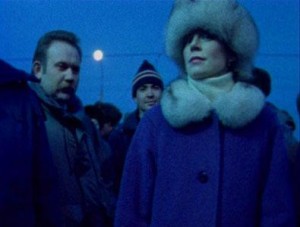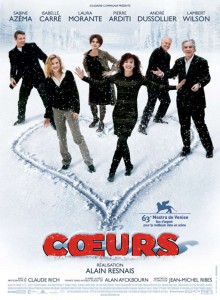From the Chicago Reader (June 10, 2005). — J.R.
It seems like hardly anyone in the U.S. ever saw Hayao Miyazaki’s Howl’s Moving Castle, despite its enormous success elsewhere, apparently not so much because kids had trouble with it as because of the adult suits handling it. But Roger Ebert gave this film only two and a half stars while assigning Mr. and Mrs. Smith three stars the same week (June 10, 2005), suggesting that one of us was probably wrong — or maybe just that Japanese kids and I are both helplessly out of touch with the American mainstream as defined by some grown-ups. — J.R.



Howl’s Moving Castle
**** (Masterpiece)
Directed and Written by Hayao Miyazaki
With the voices of Jean Simmons, Christian Bale, Lauren Bacall, Blythe Danner, Emily Mortimer, Josh Hutcherson, and Billy Crystal
The Adventures of Sharkboy & Lavagirl in 3-D
** (Worth seeing)
Directed by Robert Rodriguez
Written by Rodriguez and Racer Rodriguez
With Cayden Boyd, Taylor Dooley, Taylor Lautner, George Lopez, Jacob Davich, David Arquette, and Kristin Davis
Mr. and Mrs. Smith
no stars (Worthless)
Directed by Doug Liman
Written by Simon Kinberg
With Brad Pitt, Angelina Jolie, Vince Vaughn, Adam Brody, Kerry Washington, and Keith David
By Jonathan Rosenbaum
Sometimes movies earmarked for kids are a lot more nuanced, sophisticated, and mature than the ones that are allegedly for grown-ups. Read more
From the Chicago Reader (January 20, 1994). — J.R.

Chantal Akerman’s haunting 1993 masterpiece documents without commentary or dialogue her several-months-long trip from east Germany to Moscow — a tough and formally rigorous inventory of what the former Soviet bloc looks and feels like today. Akerman’s painterly penchant for finding Edward Hopper wherever she goes has never been more obvious; this travelogue seemingly offers vistas any alert tourist could find yet delivers a series of images and sounds that are impossible to shake later: the countless tracking shots, the sense of people forever waiting, the rare occurrence of a plaintive offscreen violin over an otherwise densely ambient sound track, static glimpses of roadside sites and domestic interiors, the periphery of an outdoor rock concert, a heavy Moscow snowfall, a crowded terminal where weary people and baggage are huddled together like so many dropped handkerchiefs. The only other film I know that imparts such a vivid sense of being somewhere is the Egyptian section of Straub-Huillet’s Too Early, Too Late. Everyone goes to movies in search of events, but the extraordinary events in Akerman’s sorrowful, intractable film are the shots themselves — the everyday recorded by a powerful artist with an acute eye and ear. Read more
A response to a poll, from Sight and Sound (January 2007). – J.R.
In order to write briefly about five films that I first saw in 2006 that are especially important to me, I have to violate a taboo against acknowledging works that aren’t (yet) readily available. More specifically, the first two on my list haven’t yet been seen very widely outside of film festivals and/or the countries where they were made, while the last two, even more rarefied, have only been shown under special circumstances, in both cases because their filmmakers are under no commercial pressures to release them and would like to oversee and monitor their exhibition. Although I’m aware that this may irritate some readers, I’d rather address them like adults than succumb to the infantile consumerist model of instant gratification, according to which works should be known about only when they can be immediately accessed. After all, some pleasures are worth waiting for.
Coeurs
Alain Resnais’ dark, exquisite, and highly personal adaptation of Alan Ayckbourn’s Private Fears of Public Places, which I saw at film festivals in Venice and Toronto, is eloquent testimony both to how distilled his art has become at age 84 and how readily Ayckbourn’s examples of English repression can be converted into French equivalents. Read more





